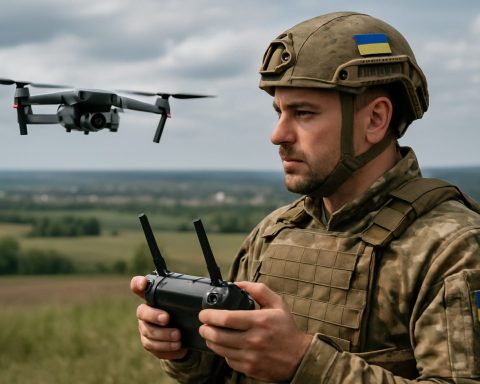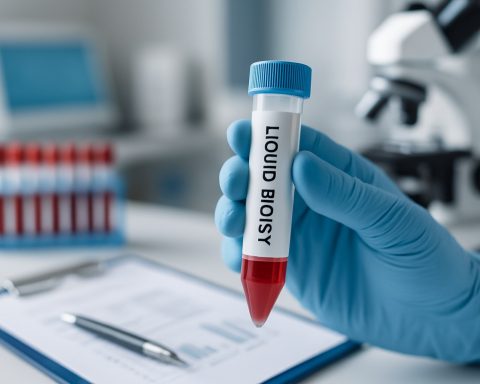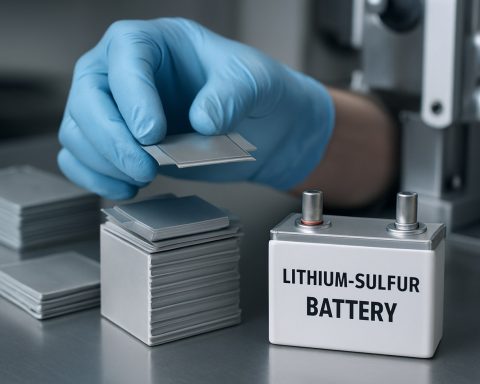Unveiling the Evolution and Impact of Drones Across Ukraine: Market Forces, Innovation, and Strategic Insights
- Market Overview
- Emerging Technology Trends
- Competitive Landscape Assessment
- Growth Forecasts and Projections
- Regional Market Analysis
- Future Outlook and Strategic Directions
- Key Challenges and Opportunities
- Sources & References
“The period from 2022 through 2025 has seen Ukraine transform into a focal point of drone deployment and innovation.” (source)
Market Overview
The use of drones in Ukraine has undergone a dramatic transformation since the onset of the Russian invasion in February 2022. Drones have become a cornerstone of both military and civilian operations, with the Ukrainian government, armed forces, and private sector rapidly scaling up their adoption and innovation. The drone market in Ukraine is projected to grow at a compound annual growth rate (CAGR) of over 20% between 2022 and 2025, driven by urgent defense needs, international support, and burgeoning domestic manufacturing (Reuters).
In 2022, Ukraine’s drone fleet was largely composed of commercial off-the-shelf (COTS) models, such as DJI quadcopters, used for reconnaissance and artillery spotting. However, as the conflict intensified, Ukraine began to develop and deploy a wider array of unmanned aerial vehicles (UAVs), including long-range strike drones, kamikaze drones, and advanced surveillance platforms. By 2023, the Ukrainian government had launched the “Army of Drones” initiative, aiming to procure and deploy thousands of drones for frontline operations (Army of Drones).
- Production Surge: Domestic drone production increased tenfold in 2023, with over 200 Ukrainian companies entering the sector. The government set a target to produce one million drones in 2024 (Financial Times).
- International Partnerships: Ukraine has received significant drone donations and technology transfers from allies, including the US, UK, and EU, further accelerating market growth (Defense News).
- Market Value: The Ukrainian drone market was valued at approximately $1.2 billion in 2023 and is expected to surpass $2 billion by 2025 (Statista).
- Key Segments: Military drones dominate the market, but there is growing demand for agricultural, logistics, and infrastructure inspection drones as civilian applications expand.
Overall, the period from 2022 to 2025 marks a pivotal era for drones in Ukraine, characterized by rapid innovation, increased production capacity, and a shift from reliance on imports to domestic self-sufficiency. This transformation is not only reshaping Ukraine’s defense landscape but also positioning the country as a significant player in the global drone industry.
Emerging Technology Trends
The use of drones in Ukraine has rapidly evolved from a niche military tool to a central component of modern warfare and civilian applications. Since the onset of the full-scale Russian invasion in February 2022, Ukraine has become a global testbed for drone technology, innovation, and tactics. This section provides a comprehensive overview of drone deployment, technological advancements, and market trends in Ukraine from 2022 to 2025.
- Military Applications: Drones have played a pivotal role in Ukraine’s defense strategy. Both reconnaissance and combat drones are used extensively for surveillance, artillery targeting, and direct strikes. Notably, the Turkish-made Bayraktar TB2 and domestically produced “Army of Drones” initiative have significantly enhanced Ukraine’s battlefield capabilities. By late 2023, Ukraine was deploying thousands of drones monthly, with estimates suggesting over 10,000 drones lost or deployed per month on both sides (NYT).
- Technological Innovation: The conflict has spurred rapid innovation in drone technology. Ukrainian startups and defense firms have developed cost-effective FPV (first-person view) kamikaze drones, electronic warfare-resistant models, and AI-driven targeting systems. The government’s goal to produce one million drones in 2024 underscores the scale of domestic production and R&D.
- Market Growth and Investment: The Ukrainian drone market has attracted significant international investment and partnerships. In 2023, the global drone market was valued at $30.6 billion, with Ukraine emerging as a key hub for military drone procurement and innovation (Statista). Western allies have supplied advanced drones, while local firms have scaled up manufacturing to meet both military and civilian demand.
- Civilian and Humanitarian Uses: Beyond the battlefield, drones are used for search and rescue, infrastructure inspection, and agricultural monitoring. Humanitarian organizations deploy drones for mine detection and delivering medical supplies to conflict zones (UNICEF).
In summary, Ukraine’s experience from 2022 to 2025 demonstrates how conflict accelerates drone adoption and innovation, positioning the country as a leader in both military and civilian drone technology.
Competitive Landscape Assessment
The competitive landscape for drones in Ukraine between 2022 and 2025 has been shaped by the ongoing conflict with Russia, rapid technological innovation, and significant international involvement. The war has accelerated the adoption and development of unmanned aerial vehicles (UAVs) for both military and civilian applications, making Ukraine a focal point for drone technology deployment and experimentation.
Key Players and Market Dynamics
- Domestic Innovation: Ukrainian companies such as Ukrspecsystems and Aerorozvidka have rapidly scaled up production of reconnaissance and combat drones. Aerorozvidka, for example, has been instrumental in developing and deploying custom UAVs for frontline intelligence and targeting.
- International Support: Western allies have supplied Ukraine with advanced drone systems, including the Turkish-made Bayraktar TB2, U.S.-made AeroVironment Puma, and Switchblade loitering munitions. These imports have significantly enhanced Ukraine’s surveillance and strike capabilities.
- Commercial Off-the-Shelf (COTS) Drones: Consumer drones from companies like DJI have been widely repurposed for military use, particularly for reconnaissance and artillery spotting. Despite export restrictions, DJI drones remain prevalent on both sides of the conflict (Reuters).
- Russian Competition: Russia has also increased its deployment of domestically produced drones and imported Iranian-made Shahed-136 drones, intensifying the technological arms race in the region.
Market Size and Growth
The Ukrainian drone market is projected to grow at a CAGR of over 20% from 2022 to 2025, driven by military demand and post-war reconstruction needs (GlobeNewswire). The government’s “Army of Drones” initiative aims to procure thousands of UAVs, further stimulating domestic production and international partnerships.
Conclusion
Ukraine’s drone sector is characterized by a dynamic mix of local innovation, international collaboration, and rapid adaptation to battlefield requirements. The competitive landscape is expected to remain intense, with ongoing technological advancements and evolving military strategies shaping the market through 2025.
Growth Forecasts and Projections
The use of drones in Ukraine has surged dramatically since the onset of the full-scale conflict in 2022, transforming both military and civilian sectors. According to a Reuters report, Ukraine’s domestic drone production increased by over 120 times in 2023 compared to the previous year, with the government aiming to produce at least one million drones in 2024. This rapid expansion is driven by urgent battlefield needs, as well as significant investments from both public and private sectors.
Market analysts project that the Ukrainian drone market will continue its exponential growth through 2025. A Defense News article highlights that the Ukrainian government has streamlined procurement and certification processes, enabling faster deployment and innovation. The Ministry of Digital Transformation has also launched initiatives to support local drone startups, further fueling market expansion.
- Military Applications: The primary driver of growth is the military sector, where drones are used for reconnaissance, targeting, and direct strikes. The Ukrainian Armed Forces have integrated both domestically produced and imported drones, with a focus on cost-effective, rapidly deployable models. By 2025, experts estimate that drones will account for up to 30% of Ukraine’s frontline reconnaissance assets (The Economist).
- Civilian and Commercial Use: Beyond the battlefield, drones are increasingly used for infrastructure inspection, agriculture, and emergency response. The Ukrainian government has signaled plans to expand regulatory frameworks to support commercial drone operations, anticipating a compound annual growth rate (CAGR) of 25% in the civilian sector through 2025 (UNIAN).
- Export Potential: As Ukraine’s drone industry matures, there is growing interest in exporting both technology and finished products to allied nations. Industry leaders expect export revenues to double by 2025, particularly in the tactical and surveillance drone segments.
In summary, the period from 2022 to 2025 is set to be transformative for Ukraine’s drone sector, with robust growth forecasts underpinned by military demand, government support, and emerging commercial opportunities.
Regional Market Analysis
The Ukrainian drone market has undergone rapid transformation since 2022, driven primarily by the ongoing conflict with Russia and the urgent need for advanced surveillance, reconnaissance, and combat capabilities. The war has catalyzed both domestic innovation and international support, making Ukraine a focal point for drone technology deployment and development in Eastern Europe.
Market Size and Growth
- According to Reuters, Ukraine’s government aimed to produce over 1 million drones in 2024, a significant leap from previous years, reflecting a market value estimated to exceed $1 billion by 2025.
- The Financial Times reports that the number of Ukrainian drone manufacturers grew from fewer than 10 in 2021 to over 200 by late 2023, indicating a robust domestic ecosystem.
Key Segments and Applications
- Military Drones: The majority of demand is for military applications, including reconnaissance, artillery spotting, and kamikaze drones. Notable models include the domestically produced “Baba Yaga” FPV drones and Turkish-supplied Bayraktar TB2s.
- Civilian and Dual-Use Drones: Civilian drones, such as those from DJI, have been repurposed for frontline use, while local startups are developing dual-use platforms for post-war reconstruction and agriculture (WSJ).
International Involvement and Supply Chains
- Ukraine has received significant drone donations and technology transfers from the US, EU, and Turkey, but faces ongoing challenges due to export controls and supply chain disruptions (NYT).
- Efforts to localize production have accelerated, with the government offering incentives and streamlined procurement to boost domestic output (Defense News).
Outlook (2024–2025)
- The Ukrainian drone market is expected to maintain double-digit growth through 2025, with increasing sophistication in AI, autonomy, and electronic warfare countermeasures.
- Post-war, the sector is likely to pivot toward civilian applications, leveraging wartime innovations for commercial and industrial use.
Future Outlook and Strategic Directions
The future outlook for drones in Ukraine from 2022 to 2025 is shaped by rapid technological advancements, evolving military strategies, and increasing international collaboration. The ongoing conflict has accelerated the adoption and innovation of unmanned aerial vehicles (UAVs), positioning Ukraine as both a significant user and developer of drone technology.
Market Growth and Investment
- Ukraine’s drone market is projected to grow at a compound annual growth rate (CAGR) of over 15% through 2025, driven by defense needs and dual-use applications in agriculture, logistics, and infrastructure monitoring (GlobeNewswire).
- Government initiatives, such as the “Army of Drones” program, have attracted significant domestic and foreign investment, with over $100 million raised for procurement and R&D by mid-2023 (Reuters).
Technological Innovation
- Ukrainian companies are rapidly developing indigenous drone models, focusing on cost-effective, easily deployable systems. Notable advancements include AI-powered navigation, electronic warfare resistance, and swarm capabilities (Defense News).
- Collaborations with Western partners have accelerated the transfer of advanced technologies, including long-range reconnaissance and loitering munitions.
Strategic Directions
- Ukraine is expected to further integrate drones into its military doctrine, emphasizing real-time intelligence, surveillance, and precision strikes. The use of drones for electronic warfare and counter-drone operations is also expanding (The Economist).
- On the civilian front, regulatory frameworks are being updated to facilitate commercial drone use, with pilot projects in agriculture and infrastructure inspection already underway.
- Ukraine’s experience is likely to influence global drone warfare and policy, as lessons learned are shared with NATO and other allies.
In summary, the period through 2025 will see Ukraine solidify its role as a leader in drone innovation and deployment, with significant implications for both national security and the broader unmanned systems market.
Key Challenges and Opportunities
The use of drones in Ukraine from 2022 to 2025 has rapidly evolved, presenting both significant challenges and unique opportunities. The ongoing conflict has accelerated drone adoption, making Ukraine a testing ground for unmanned aerial vehicle (UAV) technology in modern warfare and civilian applications.
-
Key Challenges
- Electronic Warfare and Countermeasures: Both Ukrainian and Russian forces have deployed advanced electronic warfare systems, leading to high drone attrition rates. Reports indicate that Ukraine loses up to 10,000 drones per month due to jamming and interception (The New York Times).
- Supply Chain Constraints: Ukraine relies heavily on commercial off-the-shelf drones, primarily from Chinese manufacturers like DJI. Export restrictions and supply chain disruptions have created shortages and increased costs (Reuters).
- Training and Integration: Rapid scaling of drone operations has outpaced the training of operators and the integration of UAVs into traditional military structures, leading to operational inefficiencies (The Economist).
- Regulatory and Security Risks: The proliferation of drones raises concerns about unauthorized use, espionage, and civilian safety, prompting calls for stricter regulations and counter-drone technologies (BBC).
-
Key Opportunities
- Innovation and Domestic Production: Ukraine has fostered a burgeoning domestic drone industry, with over 200 local companies producing UAVs and components, reducing reliance on imports and spurring technological innovation (Financial Times).
- Force Multiplication: Drones have enabled Ukraine to conduct reconnaissance, target acquisition, and precision strikes at a fraction of the cost of traditional systems, leveling the battlefield against a larger adversary (Wall Street Journal).
- Civilian Applications: Beyond military use, drones are being deployed for humanitarian aid, infrastructure monitoring, and agricultural management, creating new commercial markets and expertise (United Nations).
- International Collaboration: Ukraine’s experience has attracted global attention, leading to partnerships with Western defense firms and technology transfers that could benefit the country’s post-war reconstruction and export potential (Defense News).
In summary, while Ukraine faces formidable obstacles in drone deployment, the sector’s rapid evolution offers substantial opportunities for technological advancement, economic growth, and enhanced national security.
Sources & References
- Drones in Ukraine (2022–2025): A Comprehensive Report
- Financial Times
- Defense News
- Statista
- The Economist
- The New York Times
- “Army of Drones”
- Ukrspecsystems
- BBC
- GlobeNewswire
- UNIAN
- United Nations









